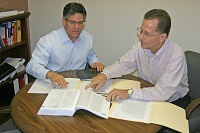 A new law recently enacted by Governor Jerry Brown expands the journal thumbprint requirement for California Notaries, while also placing further limitations on proofs of execution.
A new law recently enacted by Governor Jerry Brown expands the journal thumbprint requirement for California Notaries, while also placing further limitations on proofs of execution.
The new law, which goes into effect January 1, 2013, requires Notaries to enter signer thumbprints in their journal for any document notarization affecting real property. This is in addition to powers of attorney, deeds, quitclaim deeds, and deeds of trust that already require a thumbprint. It also prohibits Notaries from performing a proof of execution by subscribing witness on any document that affects real property.
The new law comes during a highly publicized Palm Springs murder trial, in which a thumbprint left in a Notary’s journal by one of the conspirators provided evidence for the prosecution. Details of this and several other cases involving thumbprints will be published in the November issue of The National Notary.
The California law has a potentially far-reaching effect because it broadly defines documents affecting real property. As a result, it may be challenging for Notaries to determine if a document falls within the law’s scope without reading the document or asking the signer directly.
To help California Notaries in complying with the measure, the NNA is planning a New Law Webinar later in the year. The Association also is scheduled to release The 2013 California Notary Law Primer on November 1 with information about the expanded thumbprint requirements. The reference book will include a list of some of the more common real estate documents that fall under the thumbprint requirement.
Apart from California, Illinois is the only other state to have a thumbprint requirement. However, the National Notary Association recommends asking signers for their thumbprints for all notarizations in all states. The added security measure has proven to be crucial in deterring fraud as well as assisting law enforcement in identifying wrong doers.
Kelle Clarke is a Contributing Editor with the National Notary Association.